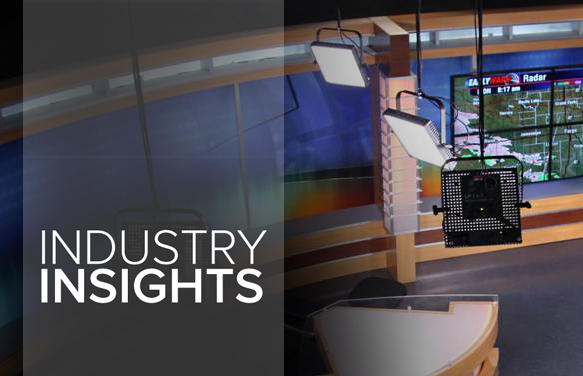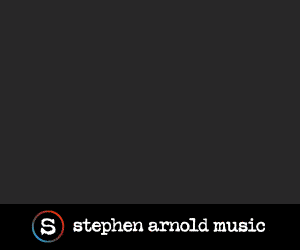Industry Insights: What to look for when lighting a TV set design

Subscribe to NCS for the latest news, project case studies and product announcements in broadcast technology, creative design and engineering delivered to your inbox.
We continue our Industry Insights series, where professionals from various design and integration firms discuss topics of relevance and importance to decision makers at TV stations.
Good lighting design adds depth to a set, creating layers of scenic elements, talent and graphics. Many things have changed in the past few years with lighting a set design, from the reduced cost of LEDs, to the emergence of on set technology, and our panel has many insights into how to make it standout on air.
This week’s question posed to the panel:
Lighting design is critical to a complete package, what should a station look for when lighting a new set design? How can it enhance talent? Is LED the best route?
Kyle Sanvictores of AKA Creative Group
LED allows the lighting within a studio to transform at a moment’s notice. Lighting brings the set to life and can make or break a design. Excellent lighting can make something look more expensive and add more depth. Without a good lighting director, even the best designed sets will fall flat and look dull.
Tim Saunders of Broadcast Design International
BDI provides the Lighting Direction on 99% of our turn-key installations. Our 3 Emmy winning LDs will create the Lighting Design, the Bill of Materials, the plots and the in-studio artistic direction. Most all of our recent clients want to make the switch to energy efficient LED instruments, which we strongly encourage. There is a hefty up-front investment, but the savings on the Electric and HVAC bills usually pay for the instruments within 18 months.
Dan Devlin of Devlin Design Group
At Team DDG, our recommendation, for now, is to stay with a solution that blends LED with fluorescent lighting technology.
In the large electronic storytelling environments we are creating, we have found that the some LED panels are not the right fixtures for the job. The problem is their photometric profile is too wide and tends to wash out the electronics when we light the interactive talent positions. Both in terms of output and control, the result is the washing out of talent, electronics, and scenic, and creating a very flat, two-dimensional on-air look.
There are Fresnel-based LED fixture that offer a little more control, but in order to light an entire set with those it would be extremely cost prohibitive. In addition, our lighting designer has concerns about some of those fixtures casting a greenish hue. It is our strong recommendation to go to all daylight (5600K) fixtures for any project featuring display technologies. Contemporary monitors, such as the storytelling walls, operate at a high color temperature range, and color calibration is extremely challenging under tungsten (3200K) studio lighting.
Our design approach combines LED key and backlight for a very sculptured, dimensional look, with fluorescent fixtures that even out the field, allowing the talent to move off their marks slightly without stepping into a dark spot.
Brendan Kilroy of Erector Sets Inc.
The advantages of today’s LED lighting are low maintenance, low energy consumption and low heat output. So by spending money on the front-end to purchase new lighting, a station can actually save money by reducing maintenance, air conditioning costs and overall electrical expense. LED is a great route but a lot of stations and Lighting Directors like to use a mix of lighting elements (typically fluorescents and LED are a great combination).
Mack Mclaughlin of FX Design Group
It typically takes more lights at a lower wattage to get a deep layered look to fight the flattening effects of HD cameras that can work at very low light levels. We use a combination of Hard Lights (fresnels) for depth, and Soft Lights (can be fluorescents) for blending, and typically light in the 40-50 Foot Candle range. We are also recommending when possible, to switch to 5600k (daylight) to help with the color balance of all of the new on set Technology.
If they went all fluorescent, we recommend they at least add some LED Fresnels back in to give them a cleaner, crisper look on air.
James Yates of James Yates Production Design
I think you need to evaluate your current resources and lighting infrastructure carefully before making decisions.
I think it is helpful to separate out the lighting resources that are needed to effectively light the talent and those needed to effectively light the set. Trying to do too many lit talent positions or too much built-in set lighting can overwhelm your budget. Every studio is different in terms of the number of fixtures, dimmers, etc. Sometimes cutting a couple of secondary talent positions, can free up the critical resources you need to make everything else look top notch.
Jeff Hall of JHD Group
Lighting design is not the cherry on top or an after thought, it is to be included at the beginning of a project. All designers rely heavily on internal or architectural lighting, this allows the scenery to become alive and truly become background for the talent. LED is the future! Saving stations money in a long term plan is accomplished by LED technology. Incentives mixed with HD all point toward LED solutions.
The Takeaway
While some views differ, many scenic designers recommend a blended approach of LED and fluorescents elements. With the heavy use of on set technology, a daylight color balance (5600K) is also recommended.
LEDs may have a higher upfront cost, but over the course of 12-18 months, they pay for themselves, creating new money in operational budgets.
Looking for more Insights?
Our panel has discussed other changes in the industry, including the move to virtual, the changing news cycle and upgrading your set design.
Subscribe to NCS for the latest news, project case studies and product announcements in broadcast technology, creative design and engineering delivered to your inbox.






tags
color balance, elements of lighting design, industry insights, LED, lighting, lighting a news set, lighting design, lighting fixtures, panel, round table, set lighting, studio lighting
categories
Broadcast Lighting Design, Exclusives, Industry Insights, Lighting and Lighting Design, Local News